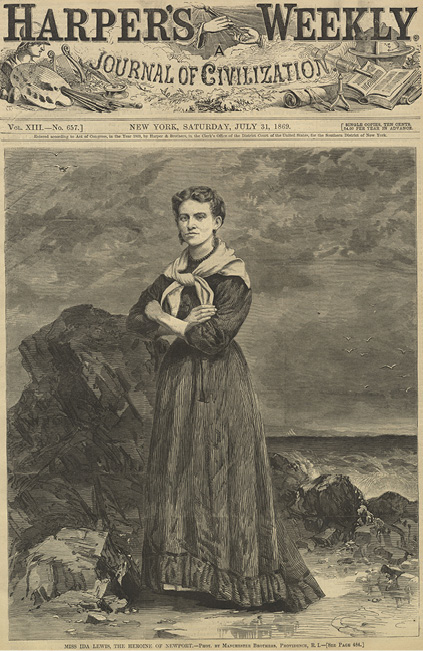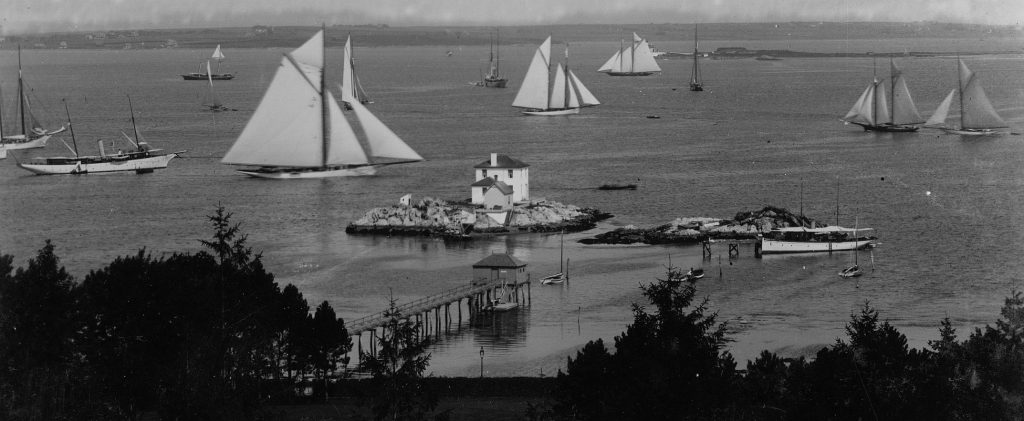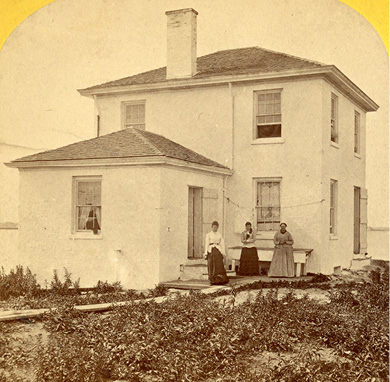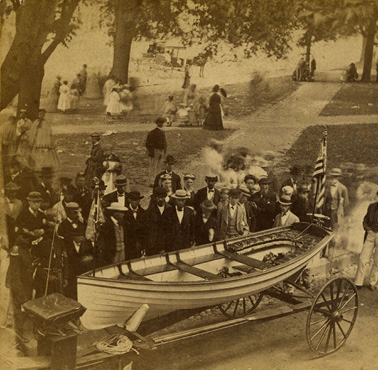By Brian M. Stinson
Editor’s note: With the Ida Lewis Distance Race presented by Bluenose Yacht Sales starting August 16, we wonder how many participating sailors – particularly those in the Youth Challenge division – are familiar with the namesake of both the race and its host yacht club. Much has been written about “the Heroine of Lime Rock,” though not always unembellished. Newport historian Brian Stinson sets the record straight.

“The Heroine of Newport” graced the cover of Harper’s Weekly on July 31, 1869. The Brian Stinson Collection
In the fall of 1858, four young men carelessly capsized their small sailboat near Lime Rock, a dangerous outcropping of jagged limestone some six hundred feet from shore inside the busy harbor in Newport, Rhode Island. The sixteen-year-old daughter of the keeper of Lime Rock Light was watching. Seeing the foursome’s futile struggle to right their craft, she launched her rowboat – alone – and skillfully plucked all of them from their life-threatening predicament.
In the winter of 1842, Idawalley Zoradia Lewis was born on Spring Street across from Saint Mary’s Church, just up the hill from the waterfront and her destiny. “Ida” would become America’s most famous lighthouse keeper and the greatest saltwater heroine of her time…perhaps all time.
In 1854, Captain Hosea Lewis was appointed as the keeper of the new light on the troublesome rocks at the southern end of Newport Harbor. This was part of the notorious triangle, the entrance to the inner harbor, which included Fort Adams and the southern end of Goat Island. The beacon was housed in a tower or “sentry box” as he called it. When weather did not permit his daily return home, he sought shelter in a small shed on the rock. Much needed improvements were planned and started, but it took nearly three years to complete the square granite lighthouse and its attached dwelling to house the commuting keeper’s family. By the time the Lewis’ and their four children moved into the lighthouse, in 1857, Ida was fifteen.
Ida’s natural love of the sea grew even stronger with the family’s new home. Already an accomplished swimmer who could outswim any boy her age in the entire town, she would become an experienced rower and a master handler of the oars. She rowed her siblings to and from school and ferried provisions out to the lighthouse because Lime Rock was not connected to the shore as it is today. Like other children raised at lighthouses she assisted in various chores: recording boat sightings, checking the beacon lantern and, of course, pulling people from the sea. Lifesaving was just another part of the job description for lighthouse keepers. In 1857, just a few months after the family took up residence at the lighthouse, Hosea Lewis suffered a stroke and became invalid.
Typically, the keeper’s wife, if he had one, would assume the responsibilities of keeping the light in such circumstances and a replacement would not be appointed. But Ida’s mother’s time was quickly taken tending to her ailing husband and an ill child as well. The lighthouse duties now rested on the shoulders of Ida, and no one could have been more suited to the task. For the next twenty-two years she faithfully kept the light as the de facto keeper of Lime Rock Light, and as at least eighteen souls and later an entire nation would attest, she was more than up to the challenges.
Ida’s series of dramatic rescues resumed eight years after the first. In 1866, a trio of soldiers from nearby Fort Adams, reportedly under the influence, went for a ride in a skiff. One of them fatefully put his foot through a bottom plank and in short order the three found themselves awash, panicked and struggling to survive. Ida Lewis was watching. She rowed out to their rescue. Upon her arrival on scene, two of the men had already disappeared. The third could still be saved, but his shock and disorientation kept Ida from pulling him into the boat. Instead, she fastened a line to him and proceeded to tow him to safety.

At the time of this photo (circa 1890), the waters surrounding Lime Rock were hazardous for mariners caught in “the triangle” during a gale. The Brian Stinson Collection/Newport Firsts: A Hundred Claims to Fame
Not long after, on a cold January morning in 1867, men working for industrialist August Belmont were on a dock in the city’s inner harbor when a valuable sheep that he engaged them to unload fell into the water and drifted away. The workers launched a nearby boat in an attempt to retrieve the prized animal. The hapless sheep rescuers were immediately imperiled by the icy harbor. Ida Lewis was watching. She saved the men and yes, also Belmont’s sheep. Not more than two weeks later she ended up pulling in a man clinging to the frigid rocks near the lighthouse. Her legend grew.
More rescues added to her already notable resume. In March of 1869, two soldiers from Fort Adams had hired a young kid named Lynch to transport them back to the fort from town. During the trip a raging gale struck the “triangle.” Ida Lewis was watching. This time she teamed with her brother Rud, and together they managed to save the soldiers, but the hired man perished.
Ida was now twenty-seven and a bona fide local heroine, but 1869 became “her year” as the rest of the nation became aware of her exploits. After her latest rescue, she received a medal from the Lifesaving Benevolent Association of New York with an award of $100. Soon after that, the Rhode Island General Assembly adopted a resolution in her honor. Her life had already been well chronicled locally, but her fame spread when Harper’s Weekly, one of the largest magazines at the time with a circulation of over 140,000, wrote of her deeds. Other national publications picked up the story.

Ida (left) with her sister and mother at their home on Lime Rock, exact date unknown The Brian Stinson Collection
On July 4, 1869, Ida was duly honored by the citizenry of Newport. A boat was built for her with funds from public subscriptions as a token of their appreciation. The presentation was held at The Parade, now known as Washington Square. They named her new rowboat Rescue. Upwards of 4,000 people attended the ceremony, where Ida was dressed in a black half-veil. After the appropriate speeches and the presentation of gifts, someone in the crowd called for the lifting of the veil. Ida did so graciously while standing in her new boat, to thunderous applause. At the conclusion, an enthusiastic “three cheers” were given to the heroine of Lime Rock.
In the following month, President Ulysses S. Grant paid a visit to Newport. As the story goes (or as legend has grown), he insisted on seeing Ida and to do so at her home on Lime Rock. The documented facts in this case, however, paint a slightly different scenario. In a well-orchestrated manner, Ida rowed aboard Rescue up to Long Wharf as the presidential party arrived to embark on the trip across the bay. Alone, she stepped up to be introduced to the President. Grant simply said, “I am happy to meet you, Miss Lewis, as one of the heroic, noble women of the age. I regret that my engagements have been such as not to allow me to call on you at your home but I hope to see you in Washington.” From that time on the rich and famous came to pay their respects at Lime Rock, including Civil War General William Tecumseh Sherman and Susan B. Anthony. Although she was hard pressed by members of the women’s rights movement, Ida maintained a neutral stance.
Ida Lewis wed Captain William Heard Wilson of Black Rock, Connecticut in 1870. The marriage lasted only two years before they separated and there was never a record of divorce. As legend would have it, this was no surprise to many, for it was said that her only true love was Lime Rock.
At about the same time, in 1872, Ida’s father died. Despite his incapacity all those years, he had retained his official appointment as keeper. Regardless of the fact that Ida, amid all her exploits, had actually kept the light all those years, her mother, as was customary, was named to fill the post. It was not until January 21, 1879 that Ida Lewis succeeded her mother and received the official appointment as keeper of the Lime Rock Light.
Ida was awarded numerous medals over her lifetime, perhaps none more important than the one she received two years after her official appointment. This particular medal has been said to be the first Congressional Medal of Honor ever awarded to a woman. In July of 1881 she was awarded the gold lifesaving medal of the United States Lifesaving Service and accepted the medal that October in a presentation at the Custom House on Thames Street (the current location of the post office). She was the second woman to receive one of these medals and the first to receive the gold.

This rowboat, named Rescue, was presented to Ida as a gift from the citizens of Newport on Independence Day, 1869. The Brian Stinson Collection/ Newport Firsts: A Hundred Claims to Fame
For the next three decades, Ida maintained her vigil on station at the light, for a total of fifty-four years. She is credited with saving eighteen souls from the sea. There were probably rescues which were not made public. And who knows how many people were saved by her averting mishaps?
Was Ida the first female lighthouse keeper in U.S. history? Lighthouse duties tended to be done by a husband and wife team. When the man died his wife assumed the responsibilities, as there were no pensions. Widows made up the largest category of women lighthouse keepers, followed by daughters. It appears the first women served in this capacity in the late 1700s. In 1828, the federal register of lighthouse keeper appointments stated there were at least ninety-five women, with eight appointed before Ida was born. Most women tended lights which were in safe locations away from danger.
As the legend has grown around Ida’s life, there was speculation as to the cause of her death. It has been heavily suggested that she heard rumors that her lighthouse would be closed, and fingers were pointed at a sensational headline and story that was run by the Newport Daily News on Thursday, October 19, 1911 which read:
TO ABOLISH LIME ROCK LIGHT
The article went on to say, “Proposition also involves the removal of Ida Lewis as Keeper” and continued, “There is a new set of officials at work on the lighthouse management and some strange things are happening.” The overall article did not support the headline and no hard facts were contained within it, but allegedly the damage was done. Two days after the Daily News headline appeared, Ida suffered a paralytic stroke and was found by her brother Rud, unconscious on the floor of her beloved family home. By Tuesday, October 24, 1911 she had died at age 69. Did the shock of that news story contribute to the death of America’s most famous lighthouse keeper? Rud Lewis had no compunction stating that viewpoint in various articles.
It’s unlikely that the newly created Lighthouse Bureau would have removed Ida, since there were no pensions at the time and there had been a long-standing policy not to turn their backs on faithful keepers and their families. In fact, it was more than sixteen years after Ida’s death that the Lime Rock Light was finally automated. Logic and hindsight would say that she had no need to worry. But logic isn’t what drives one to push off into darkness and terror of a gale, alone in a rowboat, to save lives.
Ida had lived on a rock for over fifty years serving her country and her obituary was published coast to coast, including the Boston Globe and Los Angeles Times and hundreds of newspapers in between. Not just a brief note, but headlines with lengthy attributes and drawings of the lighthouse. Evidently, this woman captivated a nation, when she appeared on the cover of Harper’s Weekly. The Civil War ended in 1865 and her image appeared four years later. The question needs to be asked; Were we or were we not looking for heroes or heroines to heal a country that had been rent to shreds?
Ida rests in the Common Burial Ground on the Farewell Street side of the cemetery, marked by an unusual gravestone of anchor and oars. Her birthplace still stands today at 283 Spring Street.
Today, the Lewis home lives on as the Ida Lewis Yacht Club, which was formally opened on July 4, 1929 in tribute to the courageous woman who risked her life for so many. The next time you sail by, take comfort. The Heroine of Lime Rock may still be watching. ■
Author, researcher and lecturer Brian Stinson graduated from St. Michaels (Newport) and Franklin Pierce College. The research historian for Newport Life Magazine for a decade and a regular contributor to Newport This Week, he’s published hundreds of articles. His book Newport Firsts hit #2 in the nation on Amazon, and he was the sole researcher for the Redwood Library & Athenaeum’s Newport: A Lively Experiment.




